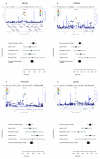Genome-wide association analysis identifies susceptibility loci for migraine without aura
- PMID: 22683712
- PMCID: PMC3773912
- DOI: 10.1038/ng.2307
Genome-wide association analysis identifies susceptibility loci for migraine without aura
Abstract
Migraine without aura is the most common form of migraine, characterized by recurrent disabling headache and associated autonomic symptoms. To identify common genetic variants associated with this migraine type, we analyzed genome-wide association data of 2,326 clinic-based German and Dutch individuals with migraine without aura and 4,580 population-matched controls. We selected SNPs from 12 loci with 2 or more SNPs associated with P values of <1 × 10(-5) for replication testing in 2,508 individuals with migraine without aura and 2,652 controls. SNPs at two of these loci showed convincing replication: at 1q22 (in MEF2D; replication P = 4.9 × 10(-4); combined P = 7.06 × 10(-11)) and at 3p24 (near TGFBR2; replication P = 1.0 × 10(-4); combined P = 1.17 × 10(-9)). In addition, SNPs at the PHACTR1 and ASTN2 loci showed suggestive evidence of replication (P = 0.01; combined P = 3.20 × 10(-8) and P = 0.02; combined P = 3.86 × 10(-8), respectively). We also replicated associations at two previously reported migraine loci in or near TRPM8 and LRP1. This study identifies the first susceptibility loci for migraine without aura, thereby expanding our knowledge of this debilitating neurological disorder.
Figures


References
-
- Launer LJ, Terwindt GM, Ferrari MD. The prevalence and characteristics of migraine in a population-based cohort: the GEM study. Neurology. 1999;53:537–542. - PubMed
-
- Stovner LJ, Zwart JA, Hagen K, Terwindt GM, Pascual J. Epidemiology of headache in Europe. Eur. J. Neurol. 2006;13:333–345. - PubMed
-
- Stovner L, et al. The global burden of headache: a documentation of headache prevalence and disability worldwide. Cephalalgia. 2007;27:193–210. - PubMed
-
- Olesen J, Lekander I, Andlin-Sobocki P, Jönsson B. Funding of headache research in Europe. Cephalalgia. 2007;27:995–999. - PubMed
Publication types
MeSH terms
Substances
Grants and funding
LinkOut - more resources
Full Text Sources
Other Literature Sources
Miscellaneous

